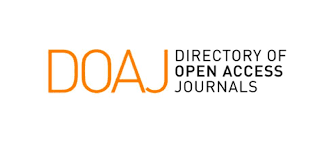Analysis of the Distribution of Volcanic Ash from the Eruption of Mount Kelud Based on Wind (Case Study of the Eruption Mount Kelud on 13 February 2014)
Abstract
The distribution of volcanic ash from the eruption of Mount Kelud on 13 February 2014 had a significant impact on atmospheric conditions in the Java Island region. This research was conducted to identify the trajectory of volcanic dust, the mass value of the particles, and the range of distribution in the atmosphere which is affected by wind conditions. The influence of the wind is based on wind direction and speed by doing wind streamline modelling. Furthermore, the assistance of volcanic ash distribution was carried out using the Red, Green, Blue (RGB) composite image method, and the particle mass and distribution range of volcanic dust was carried out using hysplit modelling. The atmospheric layer analysed at the flight level area at 16 altitudes, namely at an altitude of 1.5-16.1 km. From the results of the analysis, it was found that the maximum wind speed is 38 m/s, which is at an altitude of 16.1 km. The trajectory of the distribution of volcanic ash heads to the Northeast and then most of it turns to the Southwest due to wind direction and speed. The highest maximum particle mass value is at an altitude of 16.1 km, which is 580,000 mg/m2 with a particle distribution range of 2,600 km from the position of Mount Kelud.
Downloads
References
[2] T. J. Grindle and F. Burcham, Engine damage to a NASA DC-8-72 airplane from a high-altitude encounter with a diffuse volcanic ash cloud. National Aeronautics and Space Administration Research Center, California, 2003, pp. 1-23.
[3] A. A. Azani, C. N. Tata, Kuntinah, I. R. Nugraheni, dan A. Abdullah, Pemanfaatan produk radar cuaca dan satelit untuk mengidentifikasi abu vulkanik (studi kasus letusan Gunung Agung tanggal 26 November 2018). Seminar Nasional Pendidikan Fisika, 2019, pp. 195-203.
[4] A. H. Habibie, I. W. G. Giriharta, C. M. Lestari, dan R. M. Putra, Identifikasi Pengaruh Fenomena Siklon Tropis Cempaka terhadap Sebaran Abu Vulkanik Gunung Agung menggunakan Model PUFF dengan Inputan Data Radar dan Visual, Jurnal Meteorologi dan Geofisika, vol. 19, no. 1, 2018, pp. 1-11.
[5] D. A. Pratama, M. F. Islam, M. B. Saputro, N. D. Pamungkas, R. Fajarianti, dan R. Margiono, Deteksi Sebaran Debu Vulkanik menggunakan Citra Satelit Himawari-8 (Studi Kasus Gunung Sinabung 9 Juni 2019). Bulletin of Scientific Contribution Geologi, vol. 17, no. 3, 2019, pp 187-192.
[6] A. L. Gaol dan Y. P. Serhalwan, Simulasi Dispersi dan Trayektori Abu Vulkanik Gunung Anak Krakatau di Selat Sunda (Studi kasus: 23-28 Desember 2018). Buletin Meteorologi dan Geofisika, vol. 9, no. 8, 2019, pp. 31-37.
[7] A. S. Prabu, I. J. A. Saragih, M. P. Rosyady, dan A. Kristianto, Deteksi Sebaran Debu Vulkanik menggunakan Citra Satelit Himawari-8 (Studi kasus: Gunung Raung, Gunung Rinjani, dan Gunung Bromo). Seminar Nasional Penginderaan Jauh, vol. 5, 2018, pp. 711-715.
[8] R. E. Smallman dan R. J. Bishop. Modern Physical Metallurgy and Materials Engineering, Butterworth Heinemann, New York, 1999, pp. 24-25.
[9] J. R. Holton and G. J. Hakim, An Introduction to Dynamic Meteorology. Washington, 2019.
[10] Endarwin, Deteksi Potensi Gerak Vertikal Atmosfer Di Atas Wilayah Bandung dan Sekitarnya. Jurnal Meteorologi dan Geofisika, vol. 11, no. 1, 2010, pp. 44-53.
[11] S. Himran, Energi angin. Andi Offset, Yogyakarta, 2019.
[12] Japan Meteorological Agency, Ash RGB Detection of Volcanic Ash, Meteorological Satellite Center, Tokyo, 2015, pp. 1-10.
[13] M. Ryan dan K. R. Pratama, Identifikasi Trajektori Debu Vulkanik Letusan Gunung Gamalama dengan Hysplit dan Metode RGB pada Citra Satelit Himawari-8. Jurnal Meteorologi Klimatologi dan Geofisika, vol 4, no. 2. 2017, pp. 29-35.
[14] Angkasa Pura 1 Airport. Empat bandara ditutup sementara, 2014. Available from: https://ap1.co.id/id/information/news/detail/breaking-news-empat-bandara-ditutup-sementara, diakses pada 1 Maret 2023.
[15] Tim Analisis Kebencanaan Lingkungan LAPAN. Potensi Sebaran Abu Vulkanik Letusan Gunung Raung (Analisis Dampak Sebaran Abu Vulkanik Erupsi Gunung Raung 20 Februari 2021). 2021. Available from: http://pusfatja.lapan.go.id/siaran-pers/186/potensi-sebaran-abu-vulkanik-letusan-gunung-raung, diakses pada 1 Maret 2023.
[16] Japan Aerospace Exploration (JAXA). Jaxa Global Raindall Watch. 2014. Available from: https://sharaku.eorc.jaxa.jp/GSMaP, diakses pada 1 Maret 2023.










